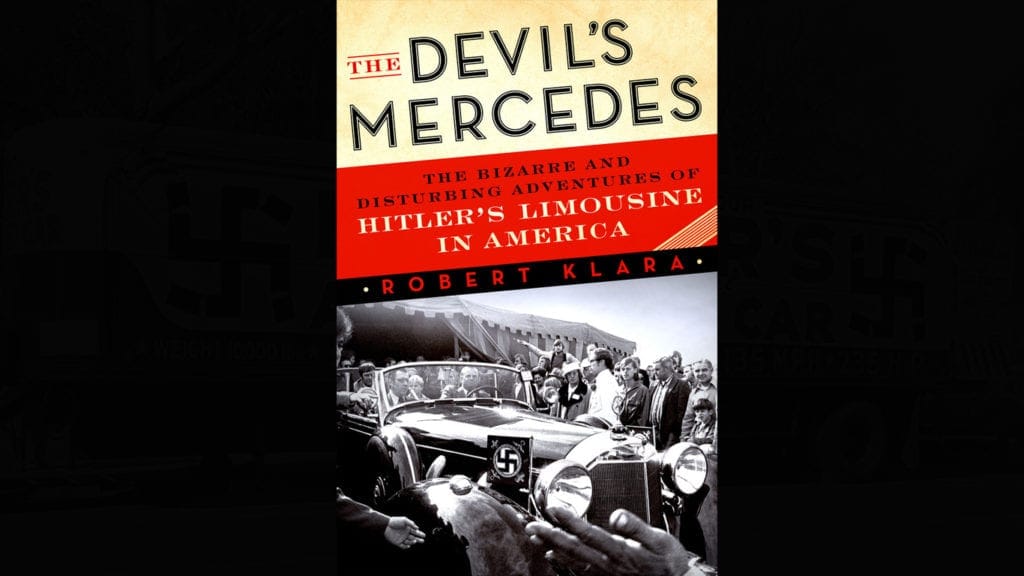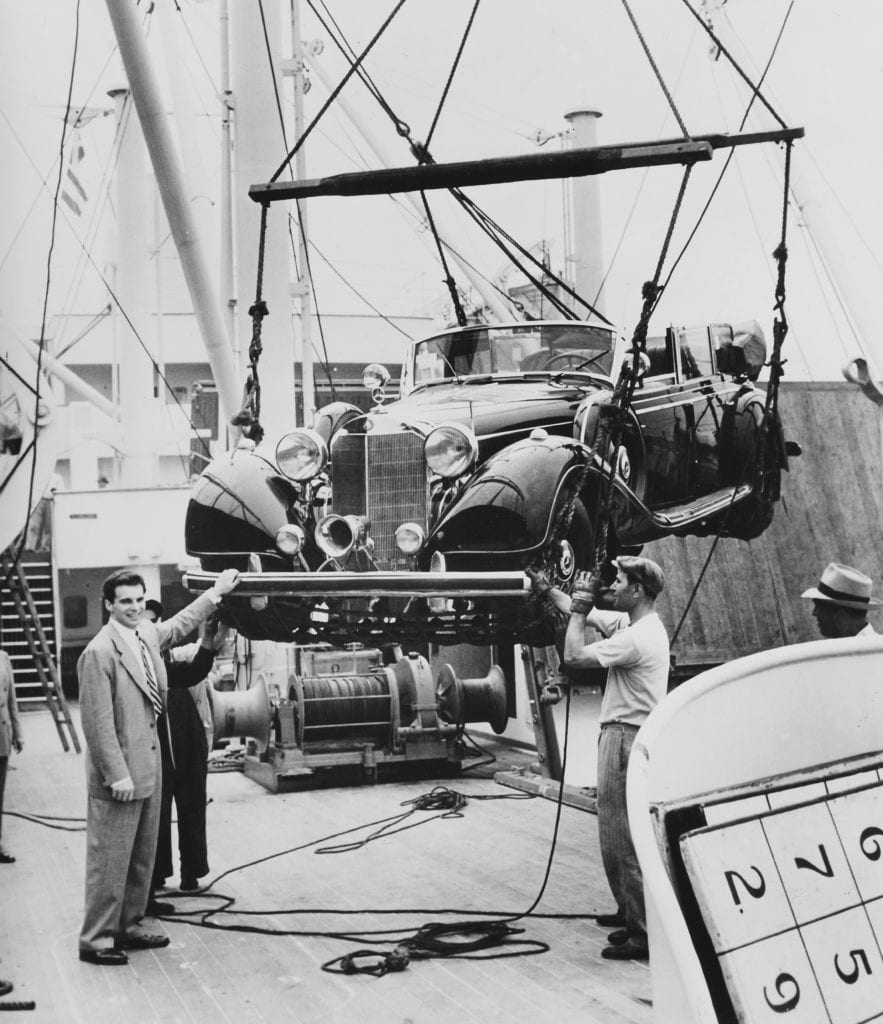The Devil’s Mercedes

Buying an antique car sight-unseen isn’t an advisable practice—unless, of course, the phone rings with a once-in-a-lifetime offer to purchase a once-in-a-lifetime automobile. In the summer of 1948, a Chicago importer named Christopher Janus received such a phone call. The man on the line was a Swede in possession of a custom-built 1941 Mercedes-Benz 770K W150 open touring car, of which fewer than 100 were built. But Janus didn’t buy the car because it was a rarity. He bought it because it had belonged to Adolph Hitler.
Or so the seller said.
The murky background of the armored, five-ton limousine that arrived in New York City on a balmy Monday three years after the end of WWII is only one of many mysteries in the pages of the new book The Devil’s Mercedes: The Bizarre and Disturbing Adventures of Hitler’s Limousine in America. Critically acclaimed author Robert Klara spent over two years ferreting out one of the most unusual episodes of American postwar history: What happened when Hitler’s limousine unexpectedly turned up on American soil.
This is actually the story of several such limousines—most of which had no real connection to Hitler, but two of which did. In the unfolding story, the sinister cars generate fortunes, ruin lives, and rekindle nightmares—even as they ultimately work to deepen Americans’ understanding of the biggest war in their history. It all begins with the passage below, excerpted with permission from the book.
The Devil’s Mercedes
A book excerpt
By Robert Klara
Janus could have had the car transported to Illinois, but he was so eager to see it that he “went to New York personally from Chicago to receive it,” he later said. June 28 was a humid Monday, the bleary skies threatening rain. Well turned out in a striped necktie and lightweight summer suit, Janus found his way to Pier 97, where West Fifty-Seventh Street ended in a splay of cobblestones in the shadow of the West Side Highway. Beyond the tall brick archway of the Swedish American Lines’ headhouse, the 11,650-ton MS Stockholm pulled at her mooring ropes as she bobbed gently in the eddies. The white paint of the ship’s 525-foot hull bore a striking contrast to the black iron shed of the pier, sticking out like a bony finger into the foul-smelling bilge of the Hudson.
Since the Stockholm could make only nineteen knots, her crossing had been slow. Coupled with the time it had taken to load the car in Sweden, Janus had waited three long weeks for this moment when his prize automobile would be hoisted from the ship’s cavernous belly.
Janus looked around and realized that many of the men on the dock were not waiting for the ship’s passengers but for him. “Word had gotten out that there was an American who had bought Hitler’s car,” he recalled, “and when I arrived at the 57th Street pier to pick it up, I was greeted by no fewer than 20 reporters and cameramen.” Janus suspected that someone at the Swedish American Line had tipped off the papers, but he was not upset. If publicity is what he wanted for his car, it might as well start now.
Possibly because so many reporters were present, Janus was invited to come up to the forecastle, where the whitewashed cargo cranes moved like giant insect legs above the chain lockers and acres of teak decking. The Stockholm’s forward hatchway lay open to the sun, hoisting cables disappearing into the inky darkness of the well below. Janus watched as the drum winches began to turn.
The car’s windshield appeared first, its thick greenish glass braced by heavy strips of chromed steel. Seconds later, a wedge-shaped grille rose into view, fronting a narrow hood that looked longer than a bowling alley. Slowly, the rest of the titanic limousine emerged from the hold, the hoisting ropes netted around the car’s fat tires straining to lift the burden. The car was nothing less than a monster—seven feet wide, and nearly as long as the front of a tenement house. The 1941 Mercedes-Benz now floating in the humid harbor breeze weighed as much as an Asian elephant, as much as two thousand red bricks, as much as the clock mechanism for Big Ben.

Even as it dangled in space, the phaeton looked like it was lunging forward, its bulbous fenders slipping over the tires like panther paws, the fat chrome exhaust hoses snaking out of the engine before diving below the running boards. In the full sunlight, Janus could see that what first looked like a big black car was actually a deep, dark blue. August and imperious, sleek and sinister, this limousine, he was assured, had been the pride and joy of the most hateful man the century had yet produced. And now it was his, all his.
The crane whirred and lifted the Mercedes over the Stockholm’s gunwale. The dockers pulled at the ropes to keep the limousine’s right front fender from grazing the pier shed, whose reflection danced ominously close in the car’s glossy paint. When the crane finally landed the tires on American asphalt, Janus pulled open the limousine’s leaden door and climbed in. He obliged the photographers by sitting on the back of the driver’s seat and waving. He seemed giddy yet a little overwhelmed. It was probably both.
“What did you pay for the car, Mr. Janus?” asked a reporter. He wouldn’t say.
“What do you plan to do with it?”
“I don’t know what I am going to do with it,” Janus said.
He looked down at the car’s dashboard, an ivory-white field of forty chrome dials and switches. The steering wheel was as big as a life preserver. The shifting rod, a stalk of glistening black steel, jutted out of the transmission below the floor, its eight-ball-size knob etched with the boxy footprint of the car’s six speeds—five forward, one reverse. It must have occurred to Janus then that had he no idea how to operate the goliath beneath him.
Janus slipped down and attempted to start the car, but the engine would not turn over. He had no way of knowing it, but it took seven steps to start the engine of a Grosser Mercedes 770K, and this one also had a hidden master switch behind the instrument panel to foil intruders. The impasse left no alternative: Stevedores ganged up and began to push the Mercedes toward the headhouse. His media moment over, Janus made a quick exit in hopes of finding license plates, gasoline—plenty of that, since the Grosser had a fifty-two-gallon tank—and, of course, someone who could teach him how to drive his new car.
Fortunately for him, help wasn’t far away. Zumbach Motor Company on West Fifty-Third Street was the official Mercedes-Benz agent for the United States. Its mechanics would hopefully know what to do with a custom-built armored touring sedan. All Janus had to do was get the Mercedes down to Zumbach’s garage. Someone conscripted an old Buick, which managed to tow the recalcitrant limousine a few blocks downtown.
* * *
The next morning’s newspapers had a field day with the story, especially the details about the automobile’s construction. The bulletproof glass was “thick as a cheese sandwich,” the car so big that Janus had to “make sure Hitler [wasn’t] in it.” The Los Angeles Times called the hulking limousine “a getaway car that would be far beyond the wildest dreams of a prohibition era gangster—and the former property of the arch gangster of all time.”
Even in a city like New York, stories this unusual didn’t happen every day. It was enough to stir the editors at The New Yorker from their high-culture perch on West Forty-Fourth Street. Philip Hamburger, from the magazine’s Talk of the Town department, tracked Janus down to ask if he might have time to give a few of his colleagues a spin in this big car of Hitler’s—say, in Central Park? Of course, Janus said.
The writers met him at the Zumbach Motors, whose tall brick garage loomed between Sixth and Seventh Avenues. There they found the ebullient Chicagoan beside his Hitler car, now sufficiently gassed up and otherwise mechanically readied. “I haven’t had so much excitement since I was voted the Blue Ribbon Baby of Charleston, West Virginia,” Janus told his visitors. Janus was also savoring his ironic triumph over the much-hated waiting list for new cars from Detroit. “I’ve been trying to get an American car for eighteen months,” he said. “Took me only thirty days get Hitler’s.”
One thing Janus didn’t mention to his guests was that many members of the public didn’t share his gee-whiz attitude toward his new car. He’d first noticed this fact the previous day. As the stevedores swung the Mercedes from the dankness of the ship’s hold, some began jeering at it. One of the booing wharfies was a man named Paul Purpi, who’d survived his four years in the Wehrmacht, emigrated to America, and didn’t much appreciate a reminder of der Führer in his new home. Reporters took note, and some had made it the lead of their stories. The following day’s Chicago Tribune ran the headline hitler’s car booed and hissed as it reaches new york. Now again, as Janus and his guests rolled around the leafy, curving lanes of Central Park, “everybody seemed to wave at us,” he said, “although some people booed as well.”
Janus took the derision in stride. Still, it was a taste of what he’d gotten himself into by purchasing an automobile associated with a figure so despised. A strange aura seemed to hang about the big car. As the long blue beast prowled down the lanes of the park, The New Yorker writers couldn’t help but remember Leni Riefenstahl’s infamous footage of Hitler standing straight as a matchstick behind the windshield, giving the Roman salute to delirious crowds spilling over the curbstones of Nuremberg. But now Hitler was dead, Germany’s cities lay in ruins, and history’s deadliest war was already three years in the past. During the surreal drive in the park, there were “no crowds, no salutes, no heils,” said the magazine. “It was a funny feeling.”

#################################################
ROBERT KLARA is the author of FDR’s Funeral Train and The Hidden White House. Hailed as “a major new contribution to U.S. history” by Douglas Brinkley, Klara’s first book earned a starred review from Kirkus. Klara’s articles and essays have appeared in The New York Times, American Heritage, and The Guardian, among numerous other publications. Klara has also worked as a staff editor for magazines including Town & Country, Architecture, and Adweek. He lives in Brooklyn.
Click to buy Robert Klara’s book on Amazon.